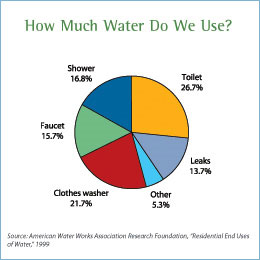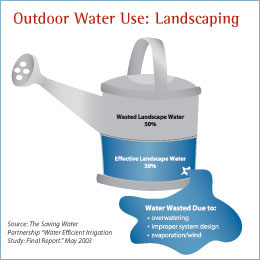Sustainable Water Infrastructure Contacts
Pacific Southwest, Region 9
Serving: Arizona, California, Hawaii, Nevada, Pacific Islands, Tribal Nations
Water & Energy Efficiency by Sectors
| Sustainable Water Infrastructure Quick Finder | ||||
|---|---|---|---|---|
| FundingGreen Jobs in the Water SectorLow Impact Development | Waste To Biogas Mapping ToolWater Conservation/EfficiencyWater-Energy Connection | Water Loss ControlWhy Sustainability? | ||

Homes
On this page:
EPA Programs & Resources
Additional Resources
- WECalc: Your Home Water-Energy-Climate Calculator
- Alliance for Water Efficiency’s
 Resource Library strives to provide the best on-line resources on water conservation and efficiency.
Resource Library strives to provide the best on-line resources on water conservation and efficiency. - People use lots of water for drinking, cooking and washing, but even more for producing things such as food, paper, cotton clothes, etc. Water Footprinting
 looks at both direct and indirect water use of a consumer or producer. The water footprint of an individual, community or business is defined as the total volume of freshwater that is used to produce the goods and services consumed by the individual or community or produced by the business.
looks at both direct and indirect water use of a consumer or producer. The water footprint of an individual, community or business is defined as the total volume of freshwater that is used to produce the goods and services consumed by the individual or community or produced by the business. - Additional links provided by WaterSense
- H2Ouse Library

- Build It Green
 offers a comprehensive package of local government support, professional training, collaboration forums, consumer education, and green product marketing to a range of stakeholders.
offers a comprehensive package of local government support, professional training, collaboration forums, consumer education, and green product marketing to a range of stakeholders.
How Much Water Is Used in Homes?


According to the United States Geological Survey’s Estimated Use of Water in the United States in 2000, less than 1% of our nation’s available water was withdrawn by individuals and families. That percentage may seem small but it represents a whopping 3,590 million gallons per day. Imagine 400,000 average-sized swimming pools—that is the staggering equivalent of 3,590 million gallons.
Americans use large quantities of water inside their homes. The average family of four can use 400 gallons of water every day, and, on average, approximately 70 percent of that water is used indoors.
The remaining 30 percent is devoted to outdoor uses. More than half of that outdoor water is used for watering lawns and gardens. Nationwide, landscape irrigation is estimated to account for almost one-third of all residential water use, totaling more than 7 billion gallons per day. Other residential outdoor uses include washing automobiles, maintaining swimming pools, and cleaning sidewalks and driveways.
How Can Water and Energy Be Used More Efficiently in Homes?
While fresh water resources appear abundant, we actually have a limited supply suitable for human use: only about of 1% of the world's water is available fresh water. You can conserve and use this precious resource more efficiently in many simple ways, ranging from turning the water off when you brush your teeth to reducing the amount of water used per flush by installing a dam in your toilet’s tank. You can also conserve and use water more efficiently through more substantial technologies and practices, like installing a greywater system (see California ![]() or Arizona
or Arizona ![]() guidelines) or changing the way you think, placing greater value on water.
guidelines) or changing the way you think, placing greater value on water. ![]()
Saving energy saves water. Making your home more energy efficient with ENERGY STAR can help to reduce high energy bills, improve comfort and help to protect the environment. Improving energy efficiency is also an important first step for homeowners interested in green remodeling. ENERGY STAR can guide you in making your home more efficient — whether you do-it-yourself or hire a qualified professional. The Department of Energy’s A Consumers Guide Energy Efficiency and Renewable Energy also provides information on how to use energy more efficiently in the home though options like:
- Renewable energy Solar, geothermal, and wind energy use negligible amounts of water compared to conventional sources of energy (e.g. coal and nuclear); investing in renewables invests in water conservation!
- A new, more energy-efficient water heater
- Replacing or upgrading an existing heating and cooling system.
You can save water in your home more directly by using water efficient products. Products that meet WaterSense criteria for water efficiency and performance carry a special label. When you use products bearing the WaterSense label, you can expect exceptional performance, savings on your water bills, and assurance that you are saving water for future generations.
A water audit is another excellent way to understand your current water use and future water savings. Generally, a water audit provides a detailed description of your water use, identifies potential water and financial savings, and recommends various water efficiency upgrades. Your local water district or public utility may provide you with a free water audit. If not, you can hire a consultant to conduct a water audit. You can use this Water Footprint Calculator ![]() to find out how much water you use in the home. You can also use the WaterSense calculator to see how much water installing WaterSense-labeled products will save.
to find out how much water you use in the home. You can also use the WaterSense calculator to see how much water installing WaterSense-labeled products will save.
You can save water by hiring certified water efficiency professionals, like WaterSense landscape irrigation professionals, Green Plumbers, ![]() and rainwater catchment professionals.
and rainwater catchment professionals. ![]()
Some experts estimate that more than 50 percent of residential irrigation water use goes to waste due to evaporation, wind, improper system design, or overwatering. You can save water by properly planning and designing your garden for the local climate, considering soil type, selecting appropriate plants, limiting turf area, efficiently irrigating with a weather-based evapotranspiration (ET) irrigation controller and maintaining that system, and using mulches and compost.
Additional Outdoor Water-Saving Opportunities
- If you have a pool, cover it when it's not being used; install an efficient pump for circulation; and avoid overfilling with an automatic fill system.
- Wash your car at a commercial car wash; they are often required to recycle water. If you wash your own car, avoid wasting water by washing it on your lawn, using an auto-shutoff nozzle on the hose, a gallon meter, and time yourself
Knowledge is power, and it can save water. WaterSense has compiled many useful fact sheets describing water efficiency practices. You can take your knowledge of energy and water efficiency a step further by getting a green education! ![]() Community Colleges like Lane in Oregon like are helping to create a green-collar work force through programs like their Water Conservation Technician Associate Degree.
Community Colleges like Lane in Oregon like are helping to create a green-collar work force through programs like their Water Conservation Technician Associate Degree. ![]()
Case Studies
- Rainwater as a Resource
 shares the details of utilizing concepts like swales, retention grading, cisterns, infiltrators and strategically-planted trees in building and landscaping design, and sheds light on the many opportunities to implement the wide array of available technologies.
shares the details of utilizing concepts like swales, retention grading, cisterns, infiltrators and strategically-planted trees in building and landscaping design, and sheds light on the many opportunities to implement the wide array of available technologies. - “In 1996, a Sydney family set out to renovate their 100 year old terrace house in the inner-city suburb of Chippendale. With a bit of vision, some common sense, and a lot of tenacity, they built what most of us would think impossible...” — A Sustainable house

- H20 House has developed a graphic-based tool that allows you to investigate the water saving opportunities in each area of your home.

